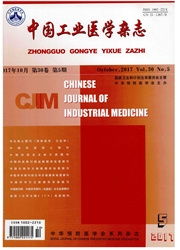

 中文摘要:
中文摘要:
目的采用个人声暴露计测量某热轧厂吊车司机个体噪声暴露,了解吊车司机噪声暴露的水平和特点。方法以某热轧厂48名吊车司机为对象,使用AWA-5610E型个人声暴露计测量白班(8:00~16:00)工人个体噪声暴露;计算8h等效连续A声级(LAeq·8h);分析噪声暴露时间变化图;根据吊车作业区域分组比较组间噪声暴露的差异。结果该厂噪声源多,吊车司机噪声暴露受多因素影响;其噪声暴露水平不稳定。测得的48例个体暴露中,LAeq·8h为(85.1±2.3)dB(A);最大值为89.9dB(A),最小值为79.1dB(A)。根据吊车作业区域分为7组,各组噪声暴露水平比较接近,在83.9-87.8dB(A)之间,经检验差异无统计学意义(F=1.20,P=0.325)。结论该厂吊车司机噪声暴露水平已超过85dB(A)的国家标准,应纳入听力保护计划以保护吊车司机的健康。
 英文摘要:
英文摘要:
Objective To measure the occupational noise exposure of overhead-traveling crane drivers in a hot rolling mill with personal noise dosimeter. Method All 48 overhead-travehng crane drivers in this mill were selected as subjects. Their day-shift (8:00 16:00)noise exposure levels were measured with noise dosimeter (AWA-5610E), and each driver's LAeq of 8 h (LAeq ·8h) were computed. According to the difference of work areas, the drivers were divided into 7 groups. Then the noise levels among the groups analyzed. Result There were many noise sources in the mill, therefore the personal noise exposure of the overhead-traveling crane drivers was not continuous. According to48 personal noise exposure data, the LAeq·8h was (85.1 ±2.3) dB (A), the highest was 89.9 dB (A), the lowest was 79.1 dB (A), the LAeq of 7 groups were between 83.9 dB (A), and 87.8 dB (A). There was no significant difference among the noise level of the groups ( F = 1.20, P = 0.325). Conclusion Noise exposure level of overhead-traveling crane drivers in this mill was over 85 dB (A), these workers should be brought into the Hearing Conservation Program for improving their health.
 同期刊论文项目
同期刊论文项目
 同项目期刊论文
同项目期刊论文
 期刊信息
期刊信息
